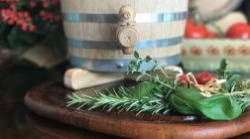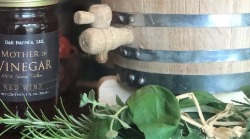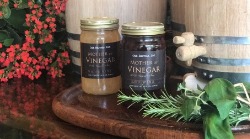View cart



Thoughts on Making VinegarBarrel-Aged Wine VinegarThere’s a certain cachet to homemade products – and wine vinegar is no exception. Good wine makes good vinegar, and good vinegar is a stellar cooking ingredient. Its balance and flavorful acidity has a lot to offer, adding a depth of flavor that differentiates naturally fermented vinegar from any manufactured one. Making vinegar is surprisingly easy. By simply combining wine, water with mother of vinegar culture and adding the most important components – time and patience, you’ll be rewarded with the full crisp flavors and nuances of your own barrel-aged wine vinegar. You may begin using your vinegar as soon as it has fully converted, however - you’ll find that the longer it ages … the better it becomes. Vinegar Oak Barrel 8 Oz Jar Mother of Vinegar Culture We recommend keeping your Vinegar Barrel shrink-wrapped and stored in a cool place away from direct sunlight until you have completed making your first quart of vinegar which will be used as the base for your barrel-aged vinegar.
Step One - Instructions 1 - Quart Jar (sterilized) 1 - 8oz Jar - Mother of Vinegar (Acetobactar aceti) 2 - Cups Wine (or Strong Flavored Beer/Ale if using Malt Culture) 1 - Cup Filtered or bottled Water (omit water if making Malt Vinegar) Cheesecloth
· Pour the Mother of Vinegar (MOV) into the sterilized quart jar. · Add 2 cups of wine and 1 cup of filtered/bottled water – aerate by stirring vigorously. · Cover the opening of the jar with several layers of cheesecloth securing it with a rubber band (the cheesecloth protects the contents by keeping dust out & fruit flies from entering).
Store the covered jar in a relatively warm (70° – 80°) and open environment that provides adequate air circulation (Ex: kitchen counter vs. inside a cabinet or pantry). In approximately 6 - 8 weeks a mother will form and float on the top of the wine giving visible confirmation that vinegar is being produced. The mother may be thick or gelatinous – others may be filmy or more like a leathery veil. Your nose is the best tool for assessing when the vinegar is done. If it smells more like vinegar than wine – it’s done. Taste it. It should taste very ‘vinegary’ and make your mouth pucker – if not … wait a few more weeks to be sure the contents have thoroughly converted. (Though most usually ‘go by taste’, for a more scientific approach, you can purchase test kits from your local homebrew or winemaking supply stores. You can use a pH meter or titration kit to check acidity and to determine whether or not the acetic fermentation is complete.) Your resulting vinegar is ‘live’ and filled with active acetobactar – it will be used as the base to add to your barrel to begin making your barrel-aged wine vinegar. Step Two - Barrel Prep Begin barrel prep by thoroughly rinsing the inside of the barrel with water. Using a rubber mallet, carefully tap in the spigot till snug. To swell the barrel, fill with water to 90% capacity (do not fill to the brim). The barrel may drip a little until the staves have swelled. Let it swell for an additional 24 hours – then empty the water.
Step Three - Barrel-Aged Vinegar 1 – 5L Oak Vinegar Barrel (prepped) 1 - Quart of ‘live’ Vinegar 2 - Quarts of Wine (or Beer/Ale for Malt Vinegars) 1 - Quart Filtered or bottled Water Cheesecloth Cork (if necessary – see notes*) Add 1 quart of converted ‘live’ vinegar, 1 quart of filtered water and 2 quarts of red wine to your 5L vinegar barrel. Cover the 3” opening with cheesecloth. Keep your barrel in a warm (70° – 80°) and ventilated area. In approximately 6 – 8 weeks conversion should have taken place and the vinegar is ready to enjoy.
Notes Feed your Vinegar Feed your vinegar monthly using the ratio of 2 parts wine to 1 part filtered/bottled water. Temperature The mother loves warmer temperatures with optimum conversion happening between 70° - 80°. Low or fluctuating temperatures will slow the process. Higher temperatures 85° to 90° will hasten conversion. Temperatures over 95° actually slow the conversion – and anything above 140° will cause the bacteria to die. Air Circulation Keep your barrel approximately 80-90% filled and in an open area that provides air movement – we’ve had some great stories of mold occurring when barrels were kept in very warm areas without adequate circulation. *Evaporation If you live in an arid area, or are noticing excessive evaporation, use the included Cork to partially lay over the top of the cheesecloth covering the hole of the barrel while still allowing for ample air/oxygen. Removing the Mother Mothers will drop to the bottom and become inactive – as your vinegar is ‘live’, a new one will form on top. Remove the inactive mothers every six months or so. OK … who spilled the fingernail polish remover? One day you might walk by your vinegar barrel and think something must have gone terribly wrong – your “vinegar” smells like fingernail polish remover. Nothing’s gone wrong … it’s just one of the stages that the vinegar goes through in its conversion from wine to vinegar. Too Robust or Acidic to’your tastebuds’ Add a little water to create a more pleasing flavor. Keep in mind that the flavor will mellow somewhat when it is aged. Aging Vinegar Vinegar has a sharp bite when first made (but still can be used for salad dressings or cooking). It becomes mellower when aged. Just like wine, the esters and ethers mature during aging and many of its finer qualities will emerge. Bottling your Barrel-Aged Vinegar If desired, your vinegar may be bottled. (Do not deplete your barrel - leave approximately 25% of your vinegar in it as this will be the base for your next batch.) Make sure your bottles are thoroughly clean and free of any soapy residue. Strain the vinegar through fine-grade cheesecloth into the very clean bottles. Fill the bottle as full as possible (to exclude oxygen from the vinegar) and cap or cork it tightly. The vinegar will continue mellowing in the bottle. Store the bottles away from light and extremes of heat or cold. Share your Mother In a small, clean jar add 1 cup of live vinegar along with a 2”-3” piece/chunk of mother. Give to friends and family so they may start their own family tradition of making fine wine vinegars.
|